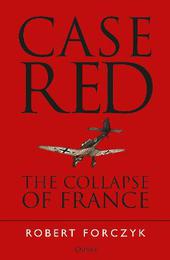
|
Case Red: The Collapse of France
Paperback / softback
Main Details
| Title |
Case Red: The Collapse of France
|
| Authors and Contributors |
By (author) Robert Forczyk
|
| Physical Properties |
| Format:Paperback / softback | | Pages:480 | | Dimensions(mm): Height 198,Width 129 |
|
| Category/Genre | Second world war |
|---|
| ISBN/Barcode |
9781472824462
|
| Classifications | Dewey:940.54214 |
|---|
| Audience | |
|---|
| Illustrations |
Plate section in colour and black and white
|
|
Publishing Details |
| Publisher |
Bloomsbury Publishing PLC
|
| Imprint |
Osprey Publishing
|
| Publication Date |
24 January 2019 |
| Publication Country |
United Kingdom
|
Description
Although the story of the German Fall Gelb offensive against France, Belgium and Holland in May 1940 is well known, most accounts tend to stop with the conclusion of the evacuation of the British Expeditionary Force (BEF) from Dunkirk on 4 June 1940. The German operation that actually conquered metropolitan France, Fall Rot (Case Red), is usually glossed over in brief. Nor are many people aware today that there was a second BEF in France, which was also successfully evacuated by sea. The current literature on the Western campaign of 1940 essentially spotlights the German drive to the English Channel and the Dunkirk evacuation then skips ahead to the French armistice, skipping over the military, political and human drama of France's collapse in June 1940. Indeed, some of the most interesting military operations of the 1940 campaign were conducted in June 1940, as the Allies mounted a vigorous counterattack at Abbeville (incl. the British 1st Armoured Division - the first time that the British Army employed an armoured division in combat) and then mounted a tough defense along the Somme River. Unlike the easy breakthrough at Sedan, the Germans had to fight hard to break through the Weygand Line. Churchill decided to second a second BEF to France to support the French, but the Germans finally achieved a decisive breakthrough before it could be effectively deployed. The British were forced to mount a second evacuation from the ports of Le Havre, Cherbourg, Brest and St Nazaire, which rescued over 200,000 troops, although the transport RMS Lancastria was sunk by German bombers, with the loss of over 4,000 troops. While France was in its death throes, politicians and soldiers debated what to do - flee to England or North Africa or to seek an armistice. The drama of the final three weeks of military operations in France in June 1940 has never effectively been captured on paper, but this is a story that needs to be told since it had great impact on the future course of World War II and Inter-Allied relations. This title will also address the initial German exploitation of France and how the windfall of captured military equipment, fuel and industrial resources enhanced the Third Reich's ability to attack its next foe - the Soviet Union.
Author Biography
Robert Forczyk has a PhD in International Relations and National Security from the University of Maryland and a strong background in European and Asian military history. He retired as a lieutenant colonel from the US Army Reserves having served 18 years as an armour officer in the US 2nd and 4th infantry divisions and as an intelligence officer in the 29th Infantry Division (Light). Dr Forczyk is currently a consultant in the Washington, DC area.
ReviewsThe book constitutes an excellent summary of the conflict in the West from September 1939 to May 1940, the best for a long time. * Ligne de Front * This is a gem of a book on a relatively little-known element of the fighting in 1940. * Miniature Wargames *
|